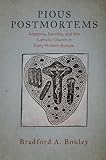Pious Postmortems : Anatomy, Sanctity, and the Catholic Church in Early Modern Europe / Bradford A. Bouley.
Material type: TextPublisher: Philadelphia : University of Pennsylvania Press, [2017]Copyright date: ©2018Description: 1 online resource (224 p.)Content type:
TextPublisher: Philadelphia : University of Pennsylvania Press, [2017]Copyright date: ©2018Description: 1 online resource (224 p.)Content type: - 9780812294446
- Autopsy -- Europe -- History -- 16th century
- Autopsy -- Europe -- History -- 17th century
- Canonization -- History -- 16th century
- Canonization -- History -- 17th century
- Human body -- Religious aspects -- Catholic Church
- Religion and science -- Europe -- History -- 16th century
- Religion and science -- Europe -- History -- 17th century
- RELIGION / Christianity / Saints & Sainthood
- History
- Medieval and Renaissance Studies
- Religion
- Religious Studies
- 235/.24094 23
- BX2330 .B68 2017eb
- online - DeGruyter
| Item type | Current library | Call number | URL | Status | Notes | Barcode | |
|---|---|---|---|---|---|---|---|
 eBook
eBook
|
Biblioteca "Angelicum" Pont. Univ. S.Tommaso d'Aquino Nuvola online | online - DeGruyter (Browse shelf(Opens below)) | Online access | Not for loan (Accesso limitato) | Accesso per gli utenti autorizzati / Access for authorized users | (dgr)9780812294446 |
Frontmatter -- Contents -- Introduction -- 1. Expertise and Early Modern Sanctity -- 2. A New Criterion for Sanctity -- 3. Negotiating Incorruption -- 4. Medicine and Authority -- 5. Engendering Sanctity -- Conclusion -- Appendix: Postmortems on Prospective Saints -- Notes -- Index -- Acknowledgments
restricted access online access with authorization star
http://purl.org/coar/access_right/c_16ec
As part of the process of consideration for sainthood, the body of Filippo Neri, "the apostle of Rome," was dissected shortly after he died in 1595. The finest doctors of the papal court were brought in to ensure that the procedure was completed with the utmost care. These physicians found that Neri exhibited a most unusual anatomy. His fourth and fifth ribs had somehow been broken to make room for his strangely enormous and extraordinarily muscular heart. The physicians used this evidence to conclude that Neri had been touched by God, his enlarged heart a mark of his sanctity.In Pious Postmortems, Bradford A. Bouley considers the dozens of examinations performed on reputedly holy corpses in the sixteenth and seventeenth centuries at the request of the Catholic Church. Contemporary theologians, physicians, and laymen believed that normal human bodies were anatomically different from those of both very holy and very sinful individuals. Attempting to demonstrate the reality of miracles in the bodies of its saints, the Church introduced expert testimony from medical practitioners and increased the role granted to university-trained physicians in the search for signs of sanctity such as incorruption. The practitioners and physicians engaged in these postmortem examinations to further their study of human anatomy and irregularity in nature, even if their judgments regarding the viability of the miraculous may have been compromised by political expediency. Tracing the complicated relationship between the Catholic Church and medicine, Bouley concludes that neither religious nor scientific truths were self-evident but rather negotiated through a complex array of local and broader interests.
Mode of access: Internet via World Wide Web.
In English.
Description based on online resource; title from PDF title page (publisher's Web site, viewed 24. Aug 2021)


